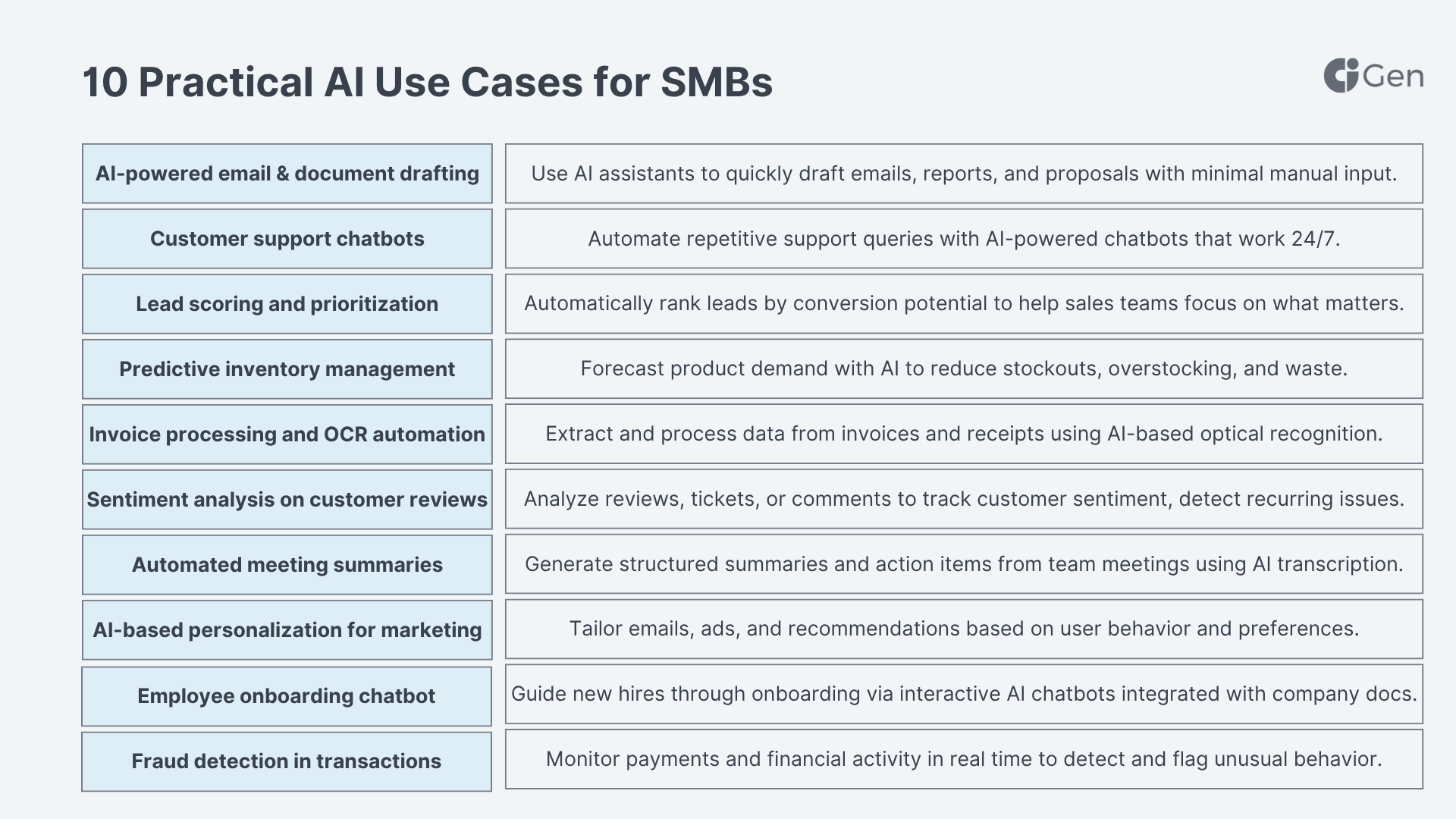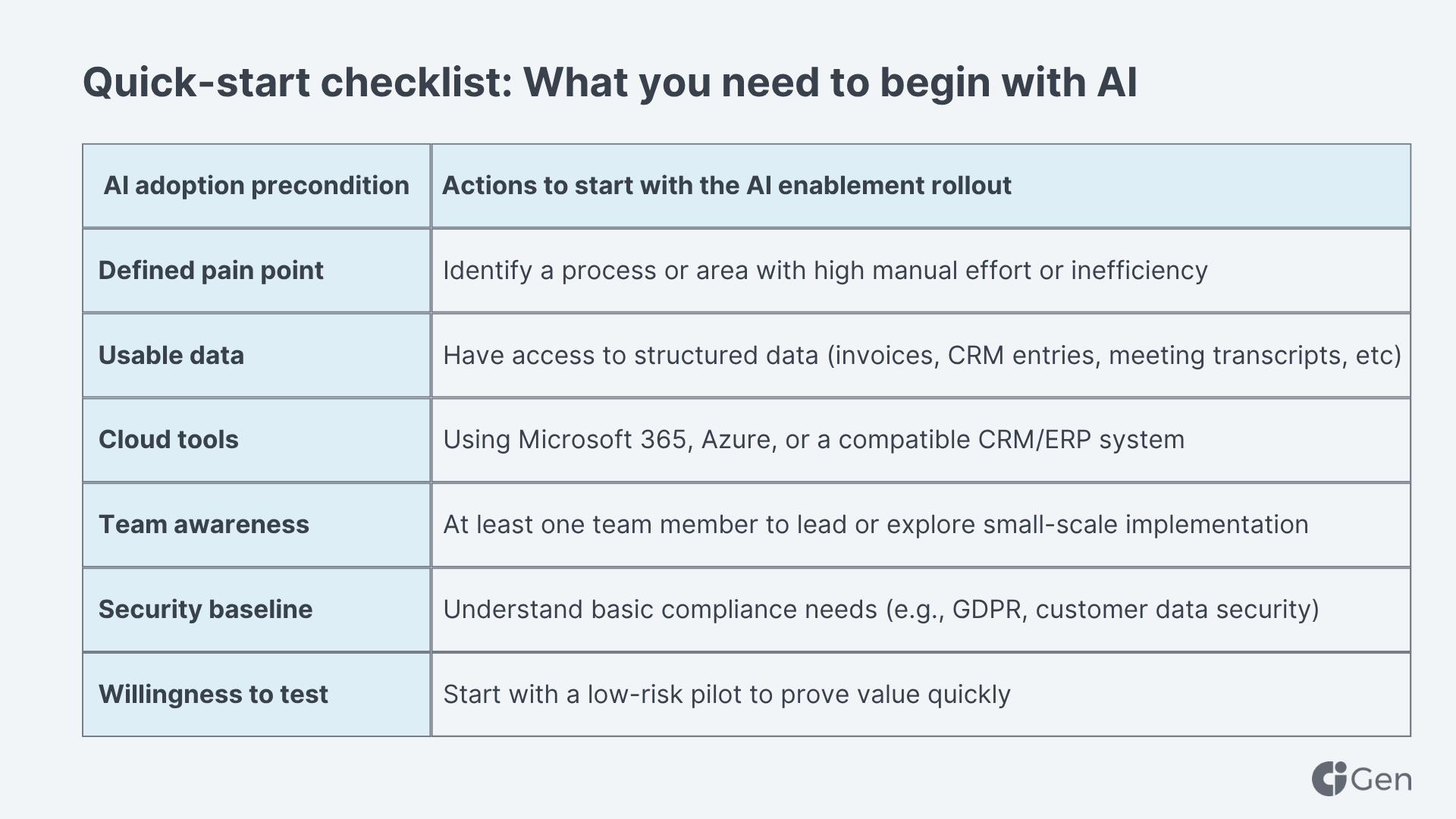Artificial intelligence (AI) has rapidly evolved from a futuristic concept into a practical business tool. Talking about AI for business, specifically for small and midsize businesses (SMBs), this shift opens the door to efficiencies and capabilities once reserved for enterprise players. Yet despite this growing accessibility, many SMBs hesitate, concerned about complexity, cost, or lack of technical expertise.
The good news? You don’t need a data science team or a huge IT budget to benefit from AI. Thanks to no-code/low-code platforms and cloud-based services like Microsoft Azure, many AI-powered tools are now within reach for companies of any size.
In this article, we’ll explore 10 real-world AI applications that SMBs can implement today, tools that save time, reduce costs, and improve decision-making. For each one, we’ll explain what it does, why it matters, and how you can get started quickly using Microsoft’s AI ecosystem or similar solutions.
Why AI matters for SMBs
SMBs often run lean teams and tight budgets. That makes productivity, efficiency, and customer retention even more critical - and that’s exactly where AI delivers the most value.
The perception that AI is expensive, complex, or reserved for large enterprises is quickly becoming outdated. In reality, small and midsize businesses are increasingly adopting AI technologies to stay competitive, streamline operations, and deliver better customer experiences. What was once considered “cutting-edge” is now practical and cost-effective, even for lean teams.
AI helps SMBs work smarter, not harder
At its core, AI is about improving efficiency and decision-making. For SMBs, this often means:
- Automating repetitive tasks - such as document processing, appointment scheduling, or customer service inquiries.
- Enhancing customer insights - using AI to analyze trends, feedback, and behavior.
- Improving forecasting - from inventory planning to sales projections, AI can spot patterns humans may miss.
- Boosting personalization - tailoring marketing, support, or product offers to individual customer needs.
Instead of replacing people, AI tools augment human effort, making small teams more effective and scalable.
“As AI adoption accelerates, creating greater efficiency, and productivity gains, the ultimate pay-off will only come to CEOs with the courage to embrace risk as opportunity. Meaning, focusing on what you can control, especially when there is so much you can't. When the business environment is uncertain, using AI and your enterprise data to identify where you have leverage is a competitive advantage. At this point, leaders who aren't leveraging AI and their own data to move forward are making a conscious business decision not to compete.”
AI is now accessible to non-technical teams
Thanks to platforms like Microsoft Azure and Microsoft 365, SMBs don’t need in-house data scientists to get started. Azure’s AI services, such as:
- Azure Cognitive Services (for language, speech, vision, and decision capabilities),
- Power Platform (for low-code automation), and
- Azure OpenAI Service (for advanced language models),
...allow businesses to integrate AI into daily operations with minimal setup.
Even tools SMBs are already using, like Excel, Teams, and Outlook, are now enhanced with AI-powered features via Microsoft 365 Copilot, requiring no coding at all.
The ROI of AI in business is real
AI delivers measurable outcomes. According to the 2024 Microsoft-IDC study on AI adoption:
- 71% of SMBs report using AI
- Businesses realize a return on their investments in AI enablement initiatives within 14 months.
- AI deployment timeframe takes under a year for 9 in 10 cases (92%).
(Source: Microsoft-IDC AI Readiness Report, 2024)
When it comes to Gen AI ROI, the fruits ripen even sooner, according to the Google Cloud’s The ROI of Gen AI survey:
- Time-to-value is under half a year, as 84% manage to realize a Gen AI project within 6 months.
- 3/4th of those who ventured to invest in Gen AI solutions (74%) are already seeing ROI.
The bottom line
For SMBs, AI represents an opportunity to level the playing field. It’s a force multiplier, helping you serve more customers, move faster, and make smarter decisions without inflating overhead. The key is to start small, focus on clear use cases, and build from there.
10 Practical AI Use Cases for SMBs
AI isn’t just about self-driving cars or robotic factories; it’s about solving real, everyday business problems. The following 10 use cases highlight practical, low-complexity ways small and midsize businesses can apply AI right now. These examples are industry-agnostic, don’t require massive investments, and can often be implemented using tools you already have or can access easily through Microsoft Azure.
For each case, you’ll find:
- A quick explainer of what the AI does
- The tangible value it delivers
- How to get started with Azure-based or Microsoft-powered tools

1. AI-powered email and document drafting
AI-powered writing assistants can help your team draft emails, proposals, reports, and meeting notes in minutes. These tools are trained to understand context, summarize long texts, and even suggest relevant phrasing, all in natural language.
Whether it’s sales follow-ups, project updates, or onboarding materials, writing takes up hours of productive time. With AI, your team can produce polished drafts faster, freeing up bandwidth for more strategic work.
How to implement it:
Tool: Microsoft 365 Copilot (available in Word, Outlook, and Teams)
What you need:
- A Microsoft 365 Business Standard or E3/E5 subscription with Copilot enabled
- Access to existing documents and emails
- Optional: integration with your CRM for more personalized outputs
Industry-agnostic examples:
- Real estate firms drafting property summaries
- Law firms preparing client briefings
- Agencies writing proposals or pitch decks
2. Customer support chatbots
AI-powered chatbots can handle repetitive customer inquiries, like tracking orders, resetting passwords, or answering FAQs, without human intervention. They can work around the clock and scale without increasing support staff.
For SMBs with limited customer service teams, chatbots ensure customers get fast, consistent answers anytime, boosting satisfaction while reducing response times and manual workload.
How to implement it:
Tool: Azure Bot Service + Azure Cognitive Services (Language Understanding + QnA Maker)
What you need:
- A structured FAQ or help center content
- Optional integration with CRM or live chat platform (e.g., Intercom, Zendesk)
- Azure account with minimal compute spend for basic bots
Industry-agnostic examples:
- eCommerce sites answering order status queries
- Healthcare clinics handling appointment scheduling
- Local services providing business hours and location details
3. Lead scoring and prioritization
AI can help automatically evaluate and prioritize incoming leads based on their likelihood to convert. Instead of treating all prospects equally, AI models analyze attributes like engagement, demographics, and past behavior to score each lead, so your sales team focuses on the highest-potential opportunities.
Manual lead qualification is time-consuming and often subjective. AI-driven scoring improves conversion rates, reduces time wasted on cold leads, and shortens the sales cycle.
How to implement it:
Tool: Dynamics 365 Sales Insights or Azure Machine Learning
What you need:
- A CRM with lead history and activity data (e.g., Dynamics, HubSpot, Salesforce)
- Basic lead attributes (industry, company size, source, engagement level)
- Pre-built or custom ML models for scoring
Industry-agnostic examples:
- SaaS firms scoring trial signups
- Marketing agencies qualifying inbound contact form leads
- B2B wholesalers segmenting high-value accounts
4. Predictive inventory management
AI can forecast product demand based on past sales, seasonality, promotions, and external factors like holidays or weather. By analyzing historical data, AI helps determine optimal stock levels, minimizing overstock and avoiding stockouts.
For SMBs with physical inventory, poor forecasting leads to tied-up capital, lost sales, or rush shipping fees. AI improves supply chain decisions, lowers holding costs, and enhances customer satisfaction.
How to implement it:
Tool: Azure Machine Learning + Azure Synapse Analytics or integration with ERP systems like Dynamics 365 Business Central
What you need:
- Historical sales and inventory data (CSV or database)
- Product categories, seasonal trends, supplier lead times
- Optional integration with POS or ERP for real-time insights
Industry-agnostic examples:
- Retailers forecasting seasonal clothing demand
- Distributors planning inventory around promotions
- Food suppliers adjusting stock based on order history
5. Invoice processing and OCR automation
AI can extract relevant information from invoices, receipts, and purchase orders, like vendor name, due date, and total amount, without manual data entry. This is made possible through Optical Character Recognition (OCR) combined with machine learning.
Manual invoice processing is repetitive, error-prone, and time-consuming. With AI, finance teams can automate data capture, accelerate approval workflows, and reduce human error, freeing up time for strategic tasks.
How to implement it:
Tool: Azure Form Recognizer + Power Automate or Logic Apps
What you need:
- Digital scans or PDF versions of invoices
- Defined fields you want to extract (vendor, date, amount, etc.)
- Power Automate flow or custom integration to push data into your ERP or accounting system
Industry-agnostic examples:
- Construction firms processing subcontractor invoices
- Hospitality businesses managing vendor billing
- Professional services firms automating expense claims
6. Sentiment analysis on customer reviews
AI-powered sentiment analysis evaluates customer feedback, emails, social media posts, support tickets, or online reviews, and classifies it as positive, negative, or neutral. It can also highlight keywords or recurring issues over time.
Monitoring customer sentiment helps SMBs understand brand perception, detect issues early, and improve services based on real feedback. It scales beyond what human teams can analyze manually.
How to implement it:
Tool: Azure Text Analytics (part of Azure Cognitive Services)
What you need:
- A source of text data: Google Reviews, Trustpilot, surveys, or support tickets
- Basic integration to extract and send the data to the API (or use Power BI for visualization)
- Optional: real-time alerts or dashboards to surface trends
Industry-agnostic examples:
- Restaurants analyzing online reviews to improve service
- SaaS companies tracking churn signals in support tickets
- eCommerce businesses identifying shipping-related complaints
7. Automated meeting summaries and action items
AI can transcribe meeting conversations and automatically generate structured summaries, highlight key decisions, and extract action items. This eliminates the need for manual note-taking and ensures better follow-through.
For busy teams, capturing everything discussed in meetings can be a challenge, especially when working remotely or across time zones. Automated summaries help ensure nothing falls through the cracks and make meetings more productive.
How to implement it:
Tool: Microsoft Teams with Microsoft 365 Copilot or Azure OpenAI Service (integrated via meeting tools)
What you need:
- Microsoft Teams with transcription enabled
- Microsoft 365 Copilot license (for native integration) or
- A workflow to send meeting transcripts to Azure OpenAI for processing
- Optionally connect outputs to Microsoft Planner, To Do, or CRM systems
Industry-agnostic examples:
- Consultants summarizing client calls
- HR teams recording interviews
- Internal project teams tracking decisions and tasks
8. AI-based personalization for marketing campaigns
AI can analyze user behavior, preferences, and engagement history to deliver personalized content, product recommendations, and timing for marketing emails, ads, or website content, at scale.
Generic messages have limited impact. Personalized campaigns increase engagement, boost conversions, and create a better customer experience, without manually segmenting lists or guessing what works.
How to implement it:
Tool: Dynamics 365 Customer Insights + AI Builder, or external tools integrated with Azure ML
What you need:
- CRM or email marketing platform with customer interaction data
- Defined segments or user attributes (purchase history, location, behavior)
- Email templates or ad creatives with dynamic fields
Industry-agnostic examples:
- Online stores recommending products based on browsing history
- Fitness studios sending tailored offers based on attendance
- SaaS platforms suggesting upgrades based on feature usage
9. Employee onboarding chatbot
AI-powered internal chatbots can answer new employee questions, guide them through company policies, and help them complete onboarding steps, all via natural conversation.
New hires often have repeated, simple questions: “Where do I submit timesheets?”, “Who do I contact for IT support?”, etc. A chatbot ensures they get instant answers while reducing the burden on HR and admin staff.
How to implement it:
Tool: Power Virtual Agents + SharePoint or Azure Bot Framework
What you need:
- A collection of onboarding documents (stored in SharePoint or OneDrive)
- Defined workflows (e.g., benefits enrollment, system access)
- A Microsoft 365 account or Azure subscription with Bot Services enabled
Industry-agnostic examples:
- Agencies onboarding remote contractors
- Retail chains training new floor staff
- Tech companies guiding junior developers through setup
10. Fraud detection in transactions
AI models can analyze transactional data in real time to detect anomalies, flagging potentially fraudulent activity such as unusual purchase patterns, location mismatches, or abnormal payment behavior.
For SMBs handling online payments, customer transactions, or vendor payouts, fraud can be costly and reputation-damaging. AI helps monitor for suspicious activity without requiring constant human oversight.
How to implement it:
Tool: Azure Anomaly Detector or custom ML models with Azure Machine Learning
What you need:
- Access to historical transaction data (e.g., time, amount, customer ID, IP location)
- Defined risk rules or a baseline “normal behavior” dataset
- Alert or dashboard setup (via Power BI or internal tooling)
Industry-agnostic examples:
- eCommerce platforms monitoring payment fraud
- Accounting teams spotting duplicate or inflated vendor invoices
- Subscription businesses detecting account abuse
These 10 use cases demonstrate that AI adoption doesn’t have to be overwhelming, expensive, or technically complex. Whether you're looking to improve how your team communicates, enhance the customer experience, or optimize operations, there’s a practical AI solution to match. Thanks to ready-to-use tools from platforms like Microsoft Azure and the Microsoft 365 ecosystem, even small teams can begin experimenting with AI in ways that deliver real business value, starting with the systems and workflows you already use every day.
Key considerations before you start
Before jumping into implementation, it’s worth reviewing a few strategic and technical considerations to make your AI rollout smooth, cost-effective, and aligned with business goals.
Start with a specific problem
Don’t adopt AI just for the sake of innovation. Focus on real business pain points where AI can improve accuracy, speed, or scalability. Use cases like customer support automation or document extraction are ideal starting points.
Data quality matters
AI thrives on data. While most SMBs already have enough data to begin (e.g., emails, invoices, CRM entries), ensure that it’s:
- Organized (e.g., consistent formatting, no duplicates)
- Accessible (from CRM, Excel, cloud storage, etc.)
- Relevant to the use case you’re targeting
Leverage your existing tools
You don’t need to build everything from scratch. Microsoft 365, Dynamics, Power Platform, and Azure already offer prebuilt connectors, templates, and AI services designed for SMBs. These are:
- Low-code or no-code
- Easy to test before scaling
- Designed to integrate with common SMB workflows
Keep security and compliance in mind
AI use must still respect customer privacy, data protection laws, and industry-specific regulations. Azure offers built-in compliance with GDPR, HIPAA, and more, but it’s essential to review what data you're processing and where it's stored.
Upskill your team gradually
You don’t need AI experts to get started, but building internal awareness is important. Consider:
- Designating a champion or “AI owner” inside your team
- Using Microsoft Learn or LinkedIn Learning for short courses
- Running a pilot before rolling out company-wide
Whilst undertaking a project as hyped about as AI enablement might seem scary, becoming a dinosaur in your niche in no time should be even more frightening. At the end of the day, most AI consulting companies offer free consultations that you can book as the first step on this journey with no obligations. Once armed with a high-level overview from top vendors, you will have a good idea of the safest way to embark on this journey for quick results.

Conclusion & next steps
AI is no longer reserved for big-budget tech firms, it’s a practical tool that SMBs can use to solve everyday challenges, improve productivity, and stay competitive. From automating repetitive tasks to gaining deeper customer insights, the opportunities are real and the barriers to entry are lower than ever.
If you’re just getting started, focus on one use case that aligns with a clear business goal, such as automating document processing or enhancing lead qualification. With platforms like Microsoft Azure, Power Platform, and Microsoft 365 Copilot, you can explore AI at your own pace, without hiring a data science team or rebuilding your tech stack.
Want help identifying which AI use case makes the most sense for your business? Reach out for a consultation, we’ll help you prioritize the right starting point, evaluate tools, and build a roadmap that fits your size, goals, and budget.








